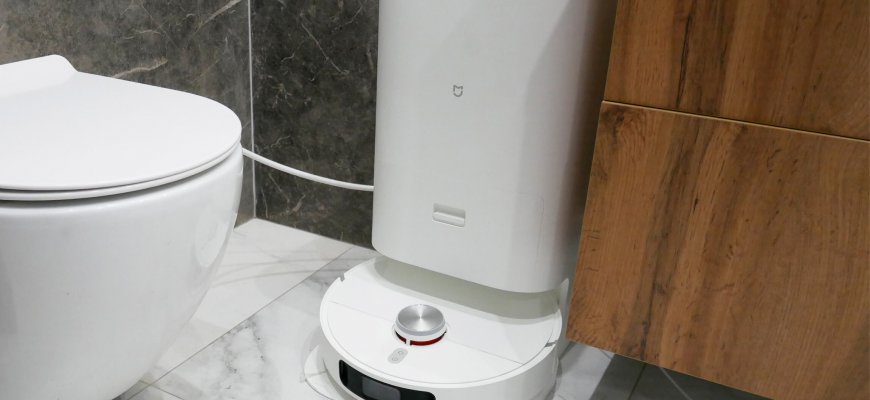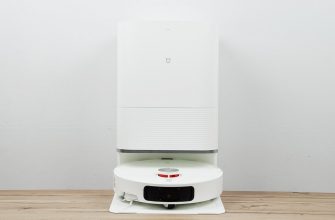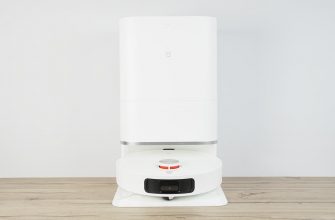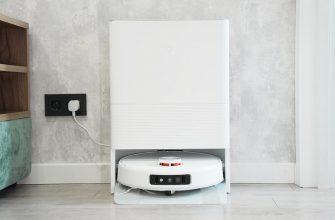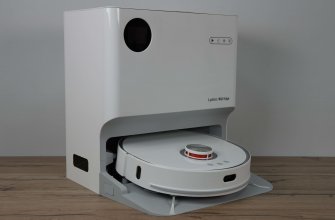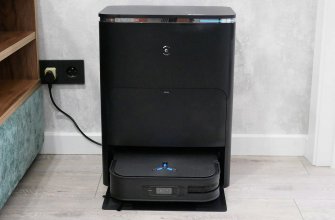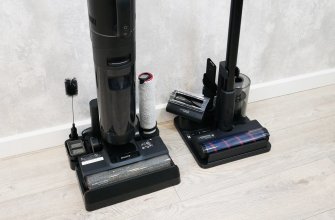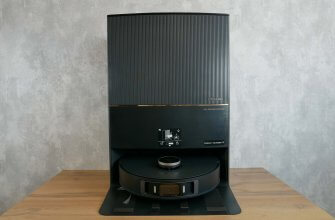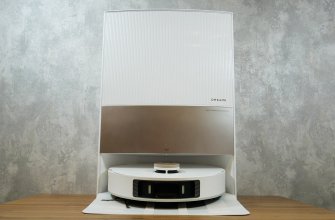Hey guys, welcome to Robotobzor! Today, we’ll look at Xiaomi Mijia Infinite Robot Vacuum-Mop 1S, the company’s last robot for 2022. This is the robot’s official name, as seen in the Mi Home app, but it’s better known as Xiaomi Mijia OMNI 1S, referencing Mijia OMNI, which is visually almost identical. Additionally, Xiaomi Mijia Sweeping and Dragging Robot 1S pops up online. To avoid confusion, the part number of the robot and station is B116+JZ2204. Meaning, it got an updated station, which has a detergent tank, but more importantly – an optionally available sewage connector. Now, I’ll review and test Mijia 1S, after which I’ll talk about the ups and downs, and compare it with the previously released Mijia OMNI B101CN, as you’re probably wondering what changed. So, let’s get rolling!
Package
Aside from the robot and station, the box includes:
- A power cord with a European plug.
- Manual in Chinese.
- Detergent tank 300 ml (10.15 Oz.).
- A tool for cleaning the robot.
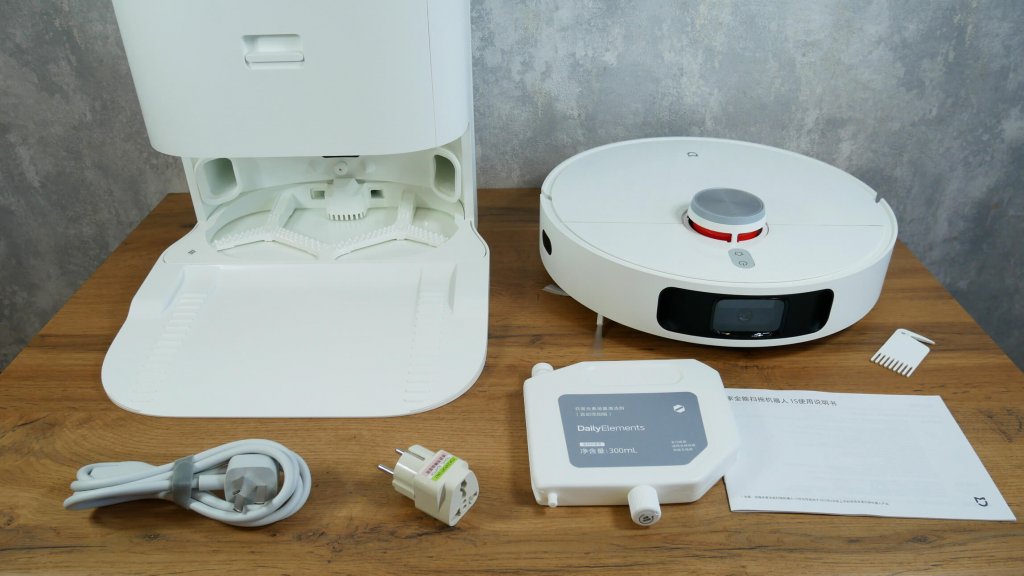
With the default kit, Mijia 1S costs between $700 and $800. Another $150 is the optionally available Module to connect to the sewer and water supply (auto water dispenser). It came in a separate box, which also contains:
- Magnetic control unit.
- Plastic tubes for connecting the station to the sewers.
- Connecting branch ½” plastic to ¼” with valve.
- Plastic clamps.
- Double-sided tape.
- Tube holder with adhesive pad.
- Perforated hose.
- Angled extension cord for connecting the tube to the station.
- Bracket stoppers for corners.
- JG Speedfit Elbow Connector.
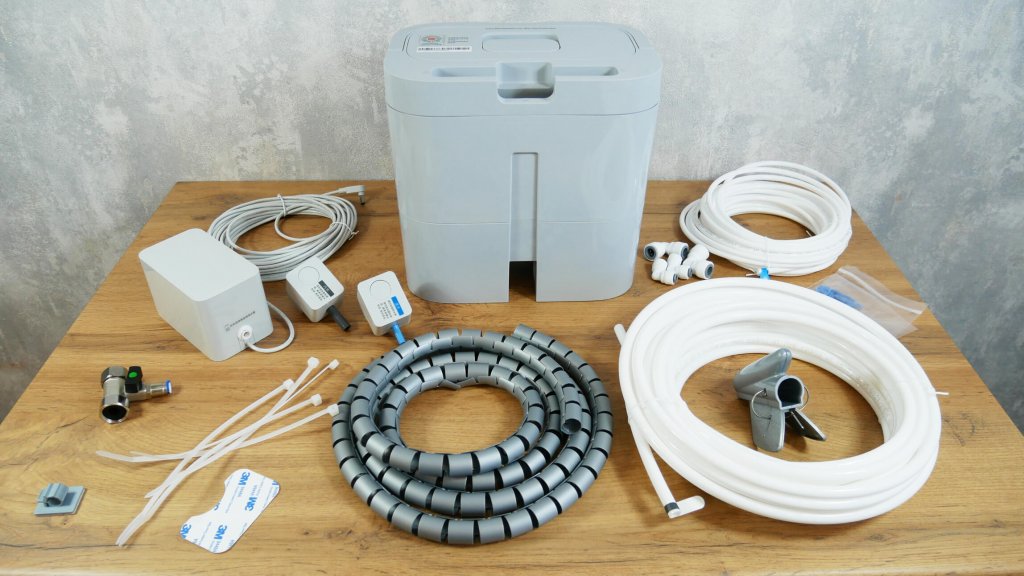
Getting ahead of myself, I can say that there’s a lot of accessories, and you won’t need to really buy anything extra.
Appearance
Now, let’s look at Xiaomi Mijia Infinite Robot Vacuum-Mop 1S’s build. Visually, the robot vacuum cleaner is absolutely identical to Mijia OMNI B101CN. The minimal difference in the lidar color, but it doesn’t change anything. So, I’ll briefly go over the robot and then move on to the station. It’s round and white. There is a wall sensor on the right side of the mechanical bumper. In the center is a system of sensors for detecting and avoiding objects on the floor.
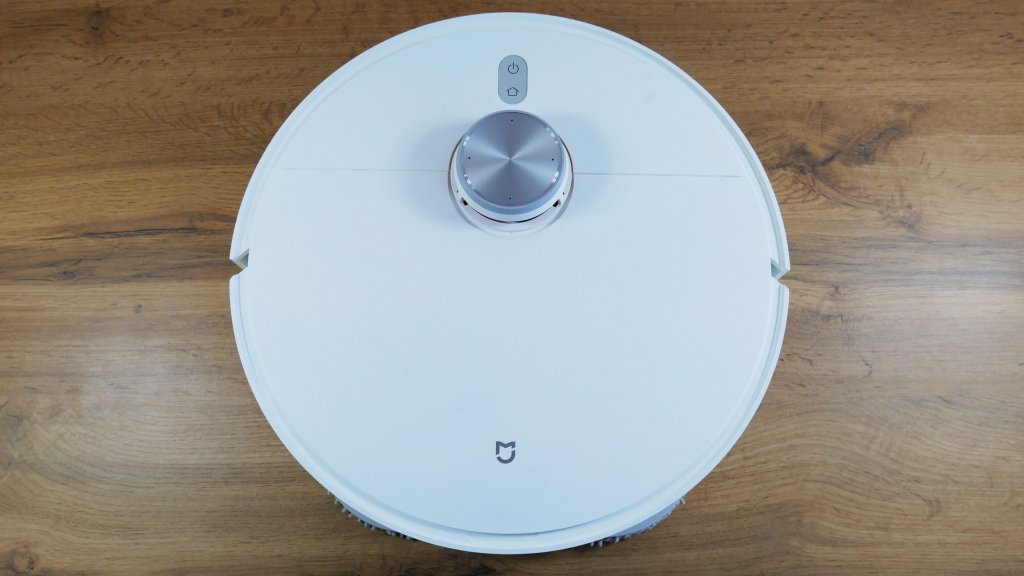
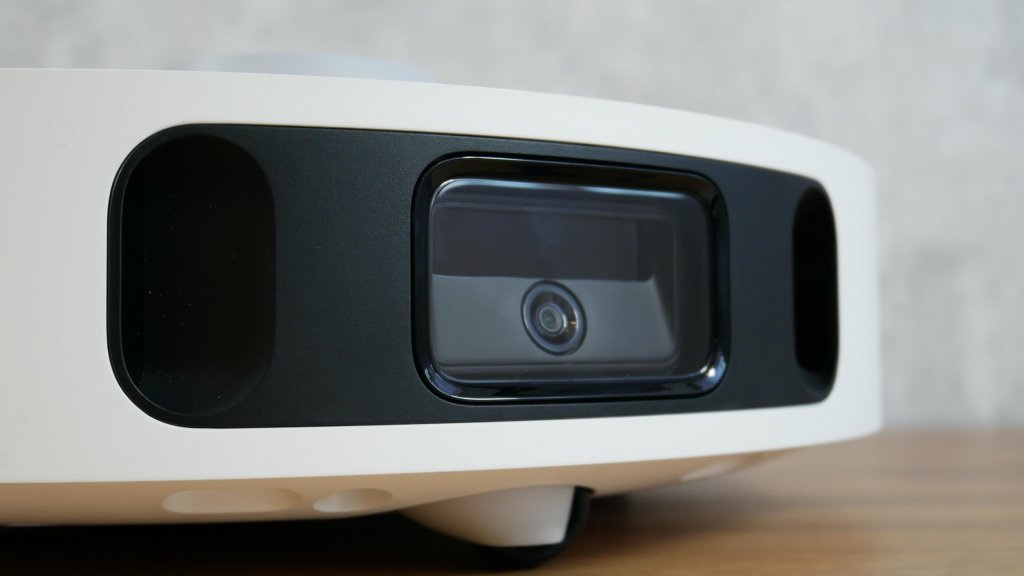
There are two buttons on the control panel. The Lidar is topped with a spring-loaded lid that protects the robot from getting stuck under furniture. Under the top cover is a dust container, which can be washed with water, like the HEPA filter. The filtration system is based on two things: fine mesh and HEPA. The water tank is hidden inside the body. It holds up to 80 ml (2.7 Oz.) of water. Water is automatically pumped at the station.

There are 4 sensors on the bottom of the body to stop it from falling. There is one three beamed side brush which is very easy to take off. The central brush unit is fluid. The brush itself is bristled. It disassembles on both sides to make it easy to take off coiled hair and fur.
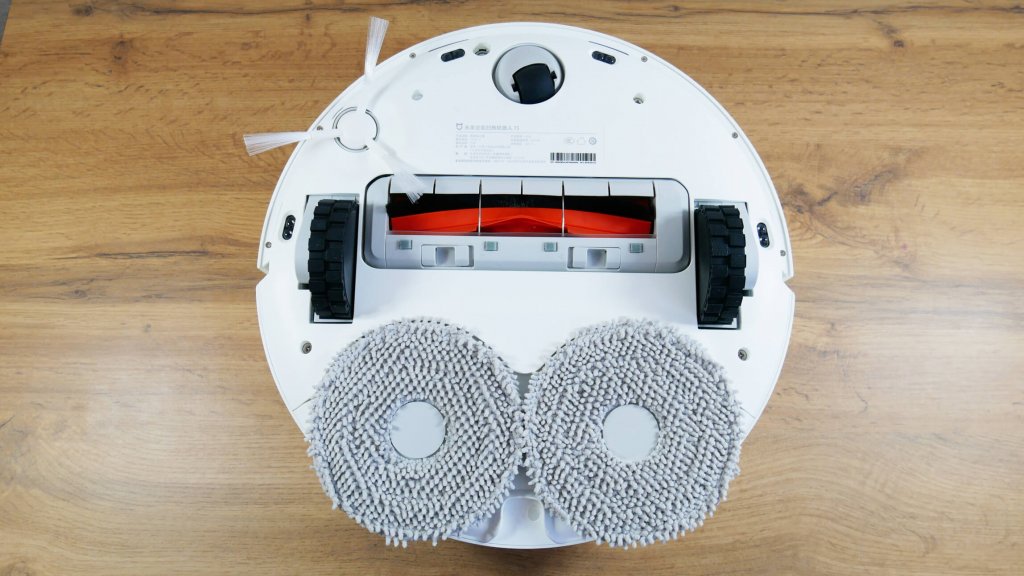
As I said in my review of the OMNI B101CN, if you wish you can order the silicone brush from the Dreame Bot L10s Ultra and install it in this robot. The size and shape are identical. The silicone brush is easier to clean from hair and fur.
The tissue holders are held magnetically. The wipes are held with Velcro. And, as a matter of fact, the wipe lifting mechanisms made possible by screwing and unscrewing the platforms themselves.
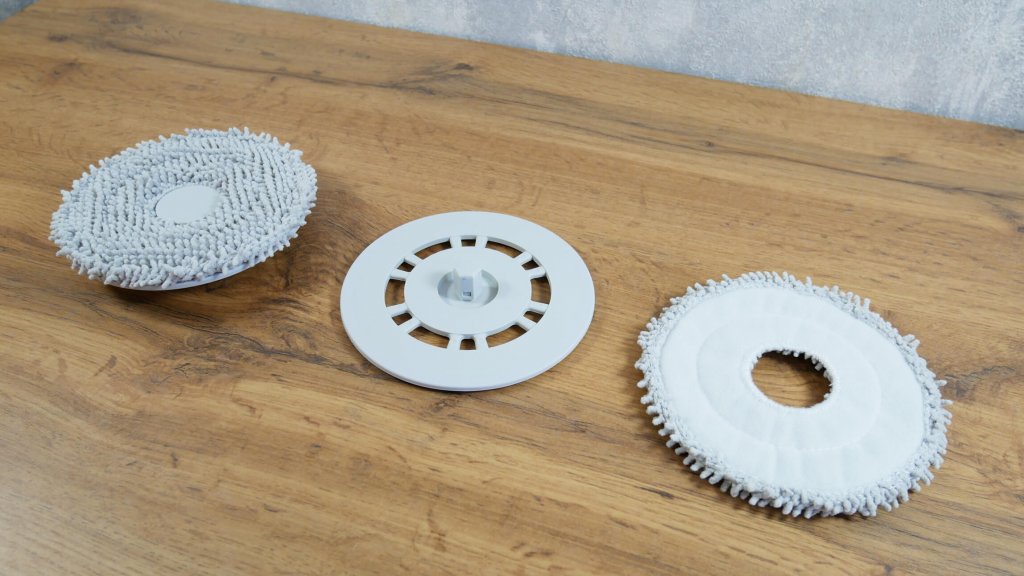
Ok, so that takes care of the robot. Let’s move on to the station. Again, it looks identical to the previous. The platform isn’t removable, but the module for cleaning the wipes themselves is removable. Underneath is a flat surface that is easy to wipe down. Above, behind the lid with a mechanical latch, is a bag for self-cleaning the dirt. It holds up to 2.5 liters (.66 G.) of dry dirt.
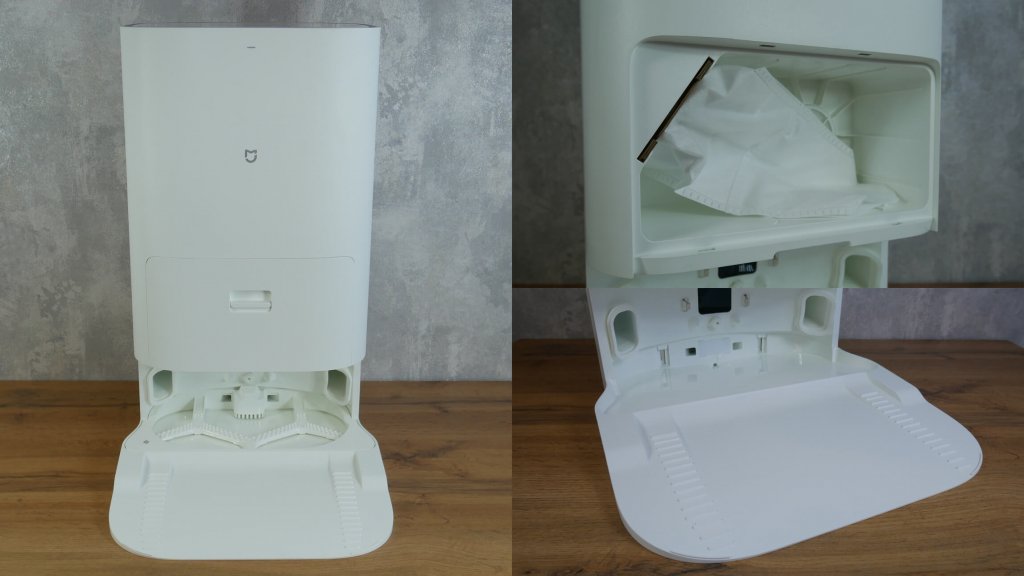
Under the top cover of the station are tanks for the dirty and clean water. They’re both standard, holding 2.5 liters (.66 G.). Between them there is a tank with detergent, and this is the first difference from the MIJIA OMNI B101CN. The tank itself is shaped the same as the Dreame Bot L10s Ultra.
Instead of the tanks, the optional sewage connection module is installed. It also has a compartment for installing a detergent cartridge. Let’s take a closer look. The top cover is sealed. We can see the residual water on it. It looks like the factory checks them before shipping, which is good. On the right side is the compartment for clean water. Inside is a float and there is even a hole in case it overflows. On the left side is the compartment for draining the waste. There is a strainer in it, which will prevent clogging of the already fine tube. The waste drains at the very lowest point of the tank.
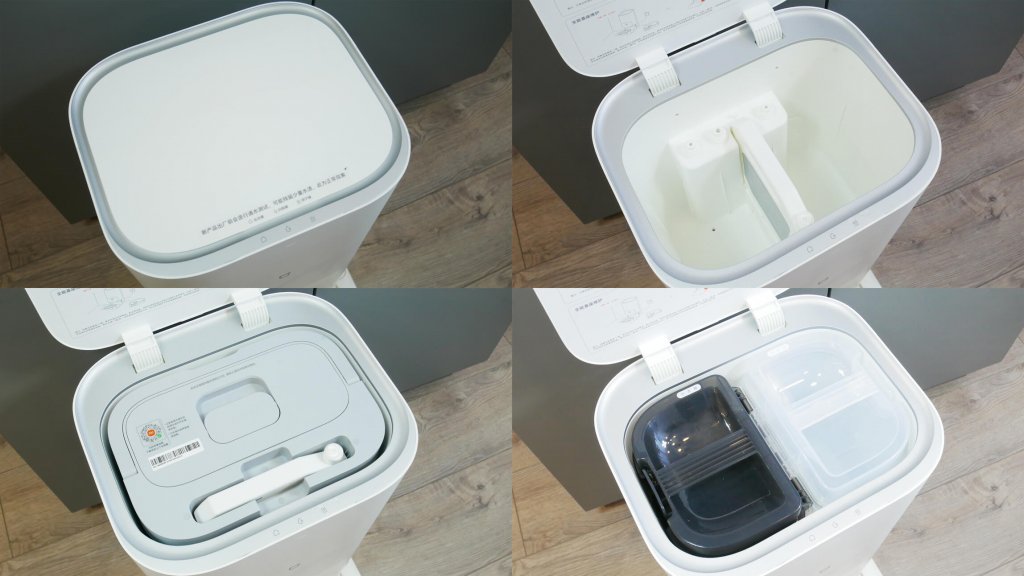
Once the module is installed in the station, remove the cover on the back of the station itself and use a Phillips head screwdriver to tighten the screw so it stays sealed. After you’re done with that, you’re ready to assemble the station.
Everything’s easy, first I installed the corner adapters, which are held on mechanical clamps. Then I measured the plastic tubes from the angle adapters to the floor, cut them off and connected them to the angles. Don’t forget to install the locking brackets, so that the connection is good. Next, connect the magnetic control unit, but this can already be done where you’ll put your station. All you have to do now is connect it to the sewage. Since this is a test sample of the robot, I didn’t bother with the connection, so the drain was organized in the toilet, and the loop-through outlet put under the sink in the bathroom. You could just as well cut the drain here, but I didn’t want to break it just for the review. But it all turned out fine and in principle the place was suitable for such a station. Here is how it looks in working condition. When I plugged the station into the outlet, the water started to fill the right compartment. The robot is ready, but let it charge a bit before.
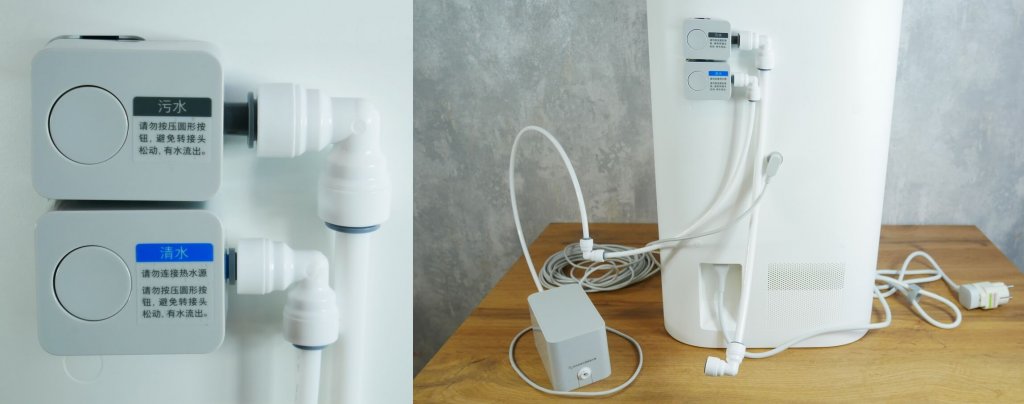
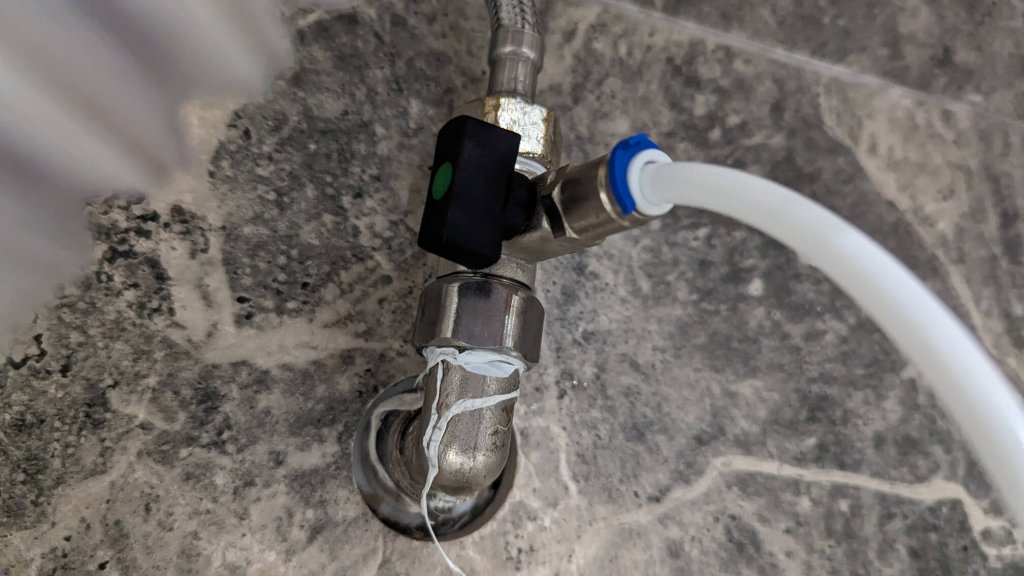
Technical characteristics
Xiaomi Mijia Infinite Robot Vacuum-Mop 1S’s main functions are up on the screen. I recommend pausing to read all of the info.
Vacuum:
- Battery Li-Ion 5200 mA*h.
- Suction power up to 4000 Pa.
- Cleaning area 200 sq.m (2152 sq.f).
- Dirt container volume 350 ml (11.8 Oz.).
- Water tank volume 80 ml (2.7 Oz.).
- Obstacle size up to 20 mm (.79 In.).
- Size: 350*97 mm (13.8×3.8 In.).
Base:
- Power usage: up to 1000 Wt.
- Clean water tank: 2,5 L (.66 G.).
- Dirty water tank: 2,5 L (.66 G.).
- Bag inside base: 2,5 L (.66 G.).
- Size: 423*340*568 mm (16.65×13.4×22.64 In.).
It’s only important to check the suction power. The other characteristics are quite standard and, compared with Mijia OMNi B101CN, don’t differ in the slightest.
Functions
Speaking of management, the robot vacuum cleaner is designed for the Chinese market, so it connects to Mi Home through the Chinese region. But I can say that the interface is in English and the application itself surprisingly doesn’t freeze, and this is a big plus for Xiaomi.
Mijia Omni 1S’s functions:
- Auto-cleaning.
- Cloth rinsing on base.
- Cloth drying on base.
- Detergent is automatically given while rinsing.
- Object detection.
- Saves multiple maps in memory.
- 3D-map of the space.
- Automatically zones space into rooms.
- Choice of zones and rooms for cleaning.
- Virtual walls and no-go zones (as well as just for mopping).
- Suction power regulation.
- Rinse interval set up for cloths (By room, every 20 sq.m (65.6 sq.f.).
- User mode.
- Cleaning log.
- Cleaning schedule.
- Automatic power increase on carpets.
- Carpet avoidance while mopping.
- Mi AI voice assistant.
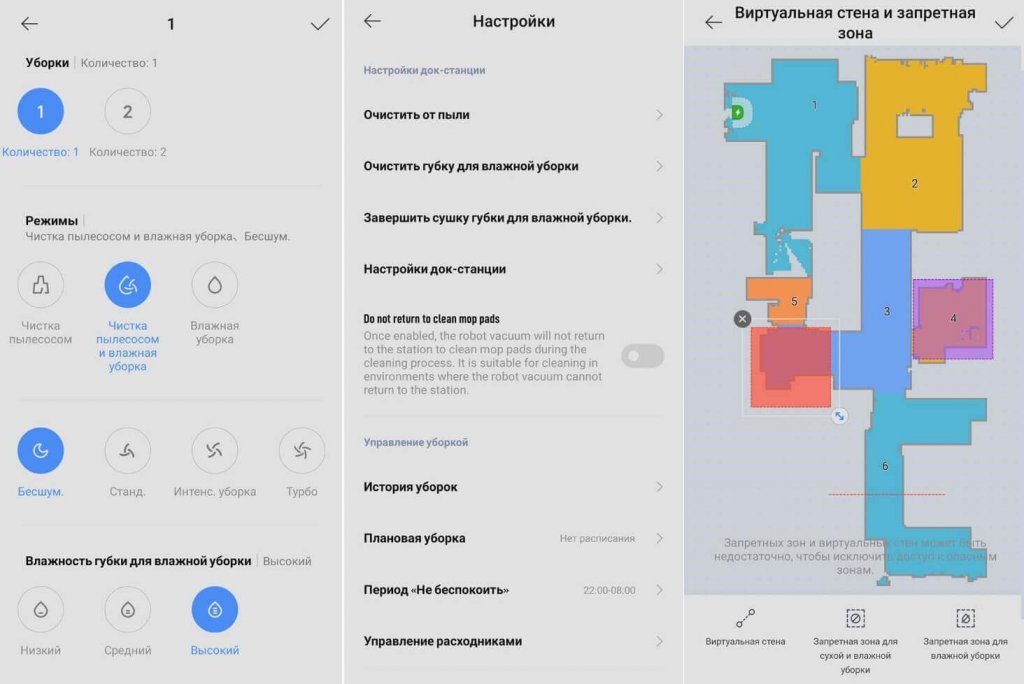
Again, the functions are identical to the previous vacuum. Only the automatic supply of detergent when rinsing wipes has been added, as well as the branded voice assistant Mi AI.
All in all, there’s a lot, but in my opinion, only the periodicity of rinsing wipes is not implemented correctly. There is no possibility to choose another area value, and 20 sq. m. (65.6 sq.f.) – is pretty big. Even 15 sq.m. (49 sq.f.) would be better.
Well, this model has no remote home camera. Only automatic detection of objects on the floor. If necessary, you can disable this function, but it’s not completely disabled, as the 3D sensors still work. Therefore, if the robot begins to behave incorrectly on fluffy carpets, unfortunately, you can’t solve the problem by turning off the object detection system.
Testing
Video review:
Navigation
Finally, let’s get to the tests. First of all, let’s test the navigation in a room with obstacles. The robot vacuum cleaner passes first along the perimeter of the room, then cleans the area in a snake like pattern. The drying rack’s legs were seen and neatly bypassed. In doing so, it separately swept around the box and chair legs, and then returned to the station. Test passed with flying colors!
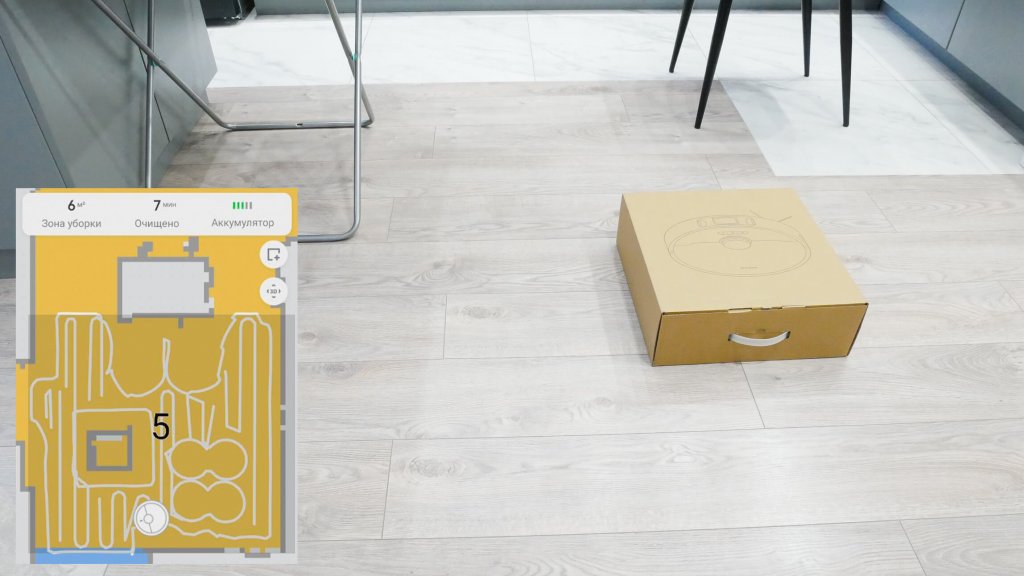
As for the rest of the house, the robot cleans room by room first along the perimeter, then in a snake like pattern. Every 20 square meters, as I found out, it returns to the station and rinses the wipes, then starts cleaning from the place it left. In the end, the apartment was cleaned with two intermediate stops at the station. Nothing left dirty, so the navigation is good on this model, just like its predecessor.
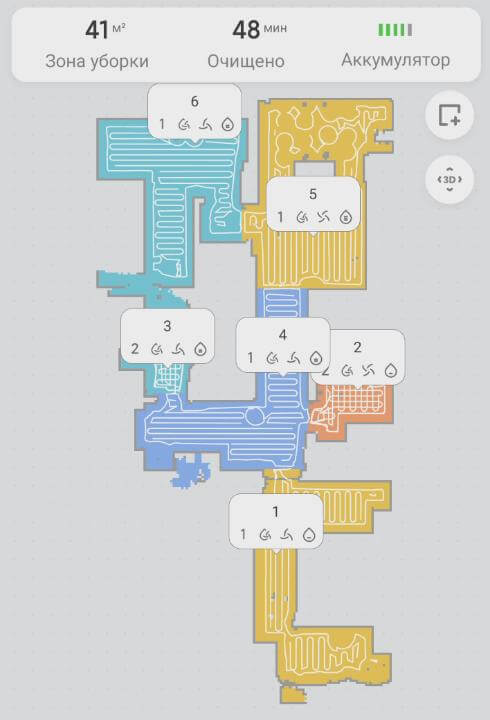
Object detection
The item detection system is good, but not perfect. It accurately bypasses 5 out of 6 objects on the floor. Only the fake dog poop was hit, as it was the smallest object. Mijia OMNI B101CN didn’t fall for this trap, but I think as a matter of chance, the navigation is the same. It is worth noting that certain items are not marked with the appropriate icons on the map. Accordingly, there are doubts that the robot recognizes them. At least there is no confirmation of this, compared with the same Dreame. It’s also worth noting that in total darkness, the object detection system goes blind, and the robot identifies lying objects on the floor even worse. This is pretty important to take into account.
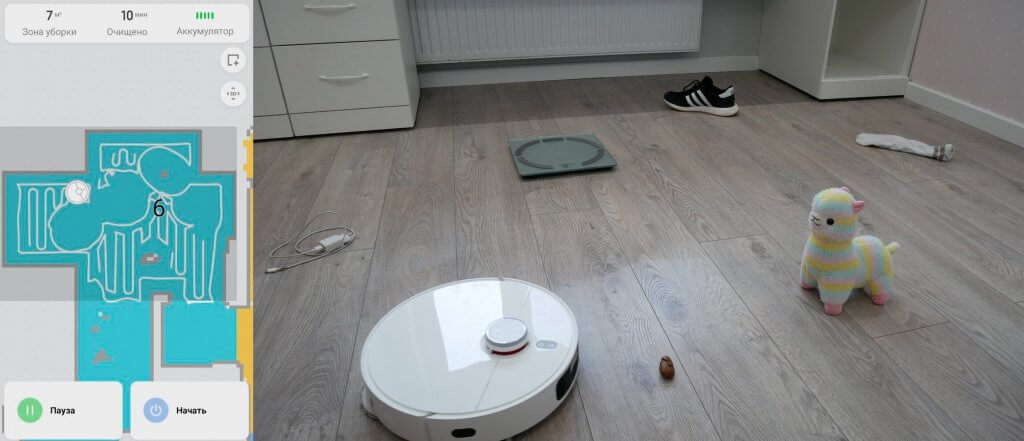
Suction power
As for the suction power, here’s an interesting point – Xiaomi Mijia Infinite Robot Vacuum-Mop 1S only sucked dirt out of slots 2 and 4 mm (.078 & .157 In.) deep. The power is increased, but not hugely. In comparison, the Mijia OMNI B101CN sucked dirt out of a 10mm (.39 In.) slot. Here I’ll share my speculations as to why this was the case. I ran this test several times to rule out randomness. Either I had some abnormal B101CN, or the Mijia engineers at the factory decided to reduce the power after all to extend the battery life. It’s at least logical, since the Dreame Bot L10s Ultra twin, and the L10s Pro, also has 4 mm of power. And given this, there is a suspicion that there could be complaints, problems with the motor in the predecessor, and they have corrected this point by reducing the motor’s power. In general, not critical, it is still powerful, though not as much as B101CN.
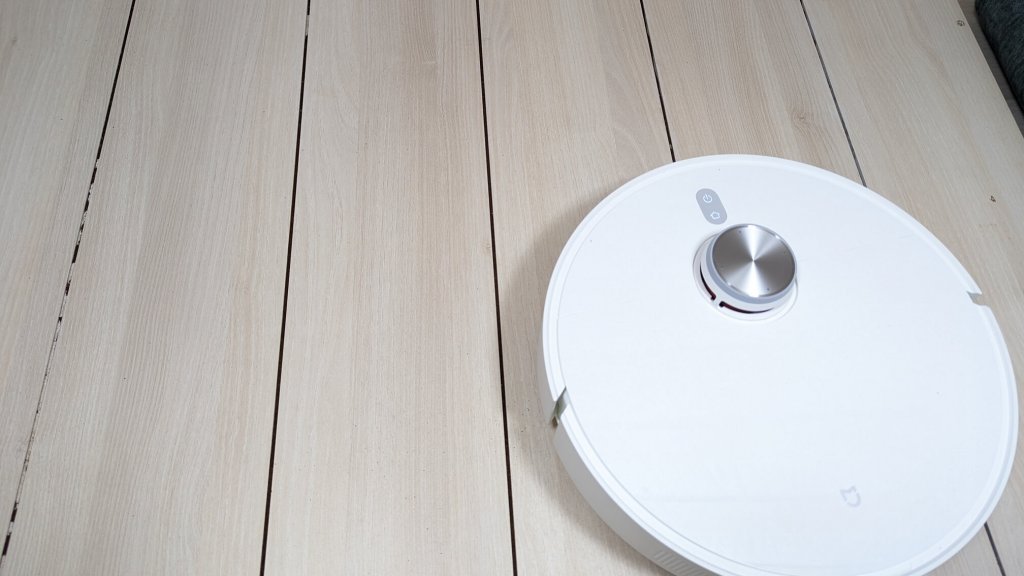
Vacuuming
It did well picking up different dirt on the laminate. Only some dirt was left in the corners, where round robot vacuums just can’t get. The central brush had some hair and fur on it, however, most of the debris was collected in the dirt container. Test passed!

Carpet cleaning
I scattered the same dirt on the carpet, and Mijia Omni did a good job. A few pieces of hair remained, but this is mostly because the object detection system prevented the robot from driving into some areas of the carpet, identifying them as obstacles. As I said before, you can’t turn this off completely, and that’s not a good thing. But the quality was good enough.

Mopping with carpets
Speaking of mopping with carpets, you can choose from two different options. The first is to automatically pick up the wipes when you hit the carpets, which allows the robot to vacuum and wipe the floor at the same time, leaving the carpets dry and clean. The second option is to turn on the automatic carpet bypass function in wet cleaning mode. This will be relevant if you have high and medium pile carpets, to completely eliminate the contact of the wipe with the carpeting if necessary.
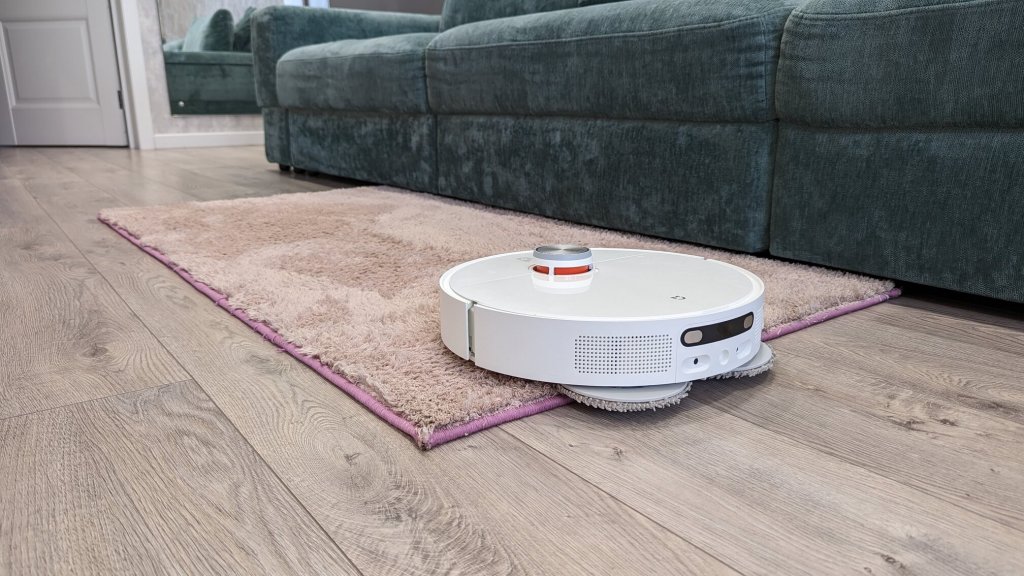
Scrubbing
It managed to scrub off dirt, after a few runs to the station for rinsing. This is the main advantage of such robots. Dirt won’t be spread across the floor during the entire cleaning process. Accordingly, in a few sweeps, the robot can clean the floor, not just wipe it clean. As predicted, a small line along the baseboard was left unwashed because the wipes don’t come out to the edges. This is a problem with all vacuums I’ve tested.

Scrubbing off harder stains
With complex dried stains Xiaomi Mijia OMNI 1S has a hard time, which is common. The wipes aren’t pressured enough to the floor, compared with special robot cleaners. In any case, it makes no sense to use it for this, just wanted to show you.

Wipe rinsing
And right away I’d like to test the station efficiency itself. Let’s start with the rinse quality. In everyday conditions after washing the floor, the wipes, let’s just say, aren’t exactly clean. And after rinsing can tell that they are actually clean. A minimal amount of dirt is washed out under a head of warm water. That’s a plus!
If you do this with a dirtier floor, the wipes on the station aren’t perfectly clean. But then again, the robot isn’t t designed for such conditions.
Here, by the way,is how the platform looks after cleaning. All it needs is a quick run through and it’ll be fine.
Self-cleaning quality
The self-cleaning quality of the vacuum is close to perfect. I ran the robot in a room with a lot of trash, and it cleaned everything perfectly and we saw that the dirt container was tightly clogged. We return the robot to the station and see that the container is completely cleaned after self-cleaning. The engineers really took their time with the self-cleaning here!
Obstacles
Mijia OMNI 1S went over 2 cm (.787 In.) high obstacles without any problems, lifting the wipes in the process. That’s cool!
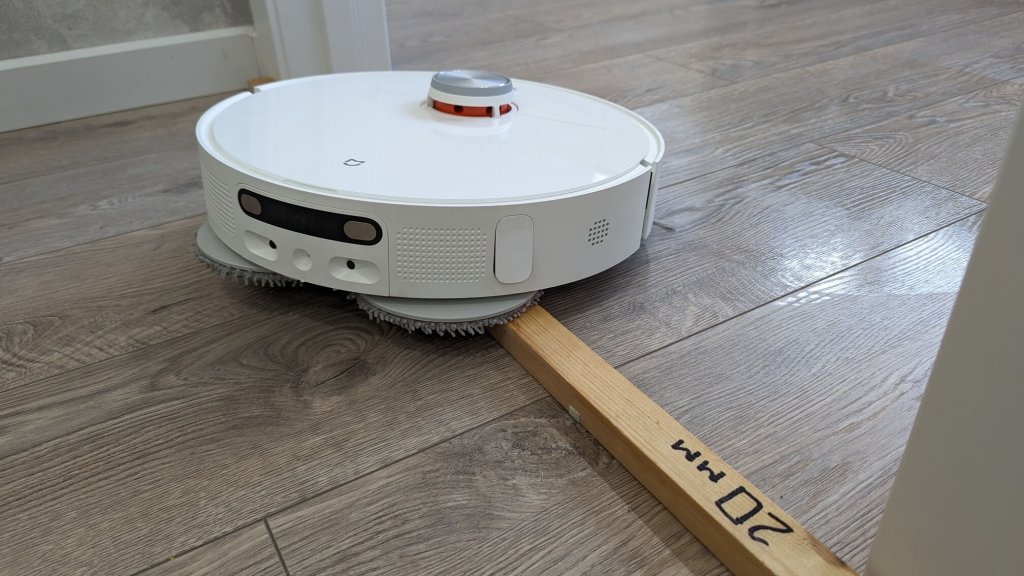
Dark spaces
It’s also not afraid of black spaces, freely going over a dark mat, just like the Mijia OMNI B101CN. This is another great advantage!
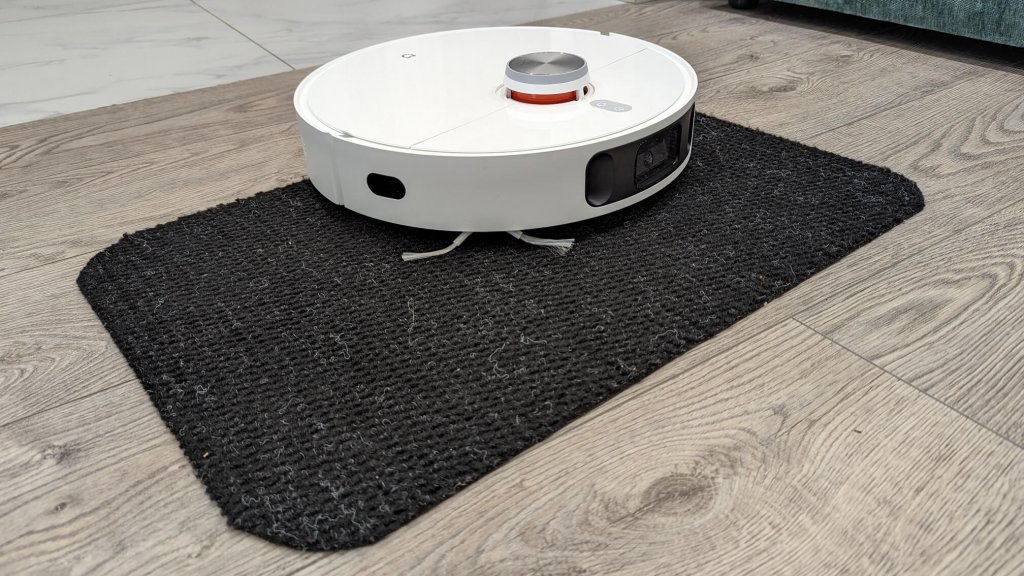
Volume
As for the volume, with the suction turned off it’s between 57.5-59 dB. At standard power the volume goes up to 60-61 dB. In “Strong” mode, the volume increases to 63-64 dB, and at max power,it peaked at 73 dB. The Volume is the same as that of the earlier model, which was actually more powerful.
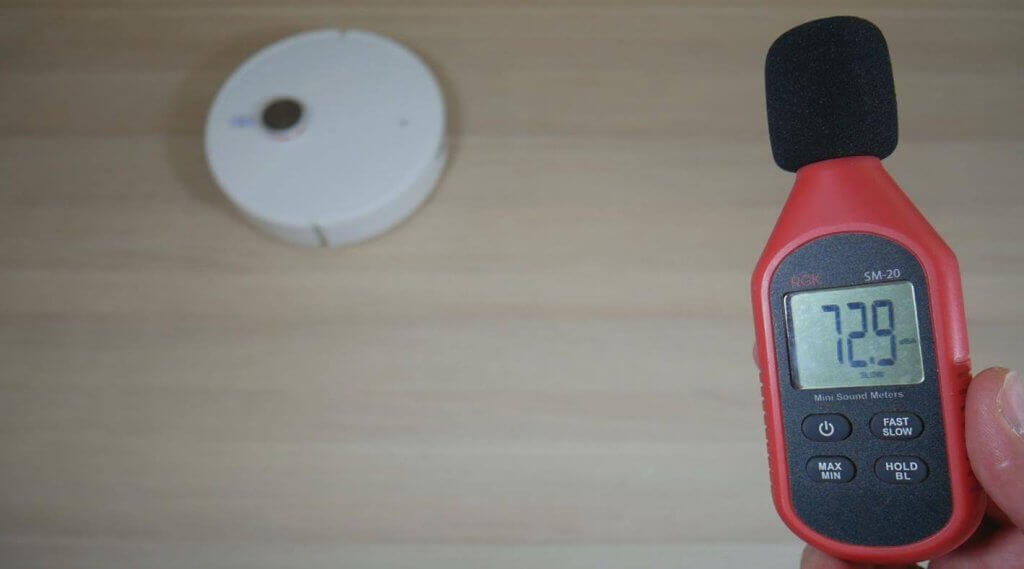
Observations and recommendations
I’ve finished all the tests, now I’ll tell you all the tidbits I found during my tests. I’ll also answer the questions in my comments, and move on to the scores.
Well,first of all, as also seen in Mijia OMNI B101CN and Dreame Bot L10s Ultra, this robot has a problem with supplying water from the reservoir to the wipes while cleaning. I even removed the wipes to see if the water was dripping from the holders. But no, no water flowed. Trying pumping the system with a syringe, as they say on some forums, doesn’t help.
Specifically with this model, I found something else. When the module for the sewage was installed, the waste water didn’t drain from the tray into the station and so went further into the sewer. And no matter how much I pumped with a syringe, the water stayed in the tray. The problem is solved in the following way. Install the station to the usual tanks for clean and dirty water, turn on the rinse cloth function a few times, and it should easily suck the water from the pan into the tank with dirty water. Only after I installed the special module, and I didn’t see this problem again after. Some dumb mistake from the factory probably.
The next thing I already mentioned is that the object detection system can’t be completely disabled. The robot still moves away from some objects on the floor, or from the carpet edges.
And as I finish with the problem, let’s move on to the questions. Take into account that because of the corner connectors the station can’t get too close to the wall. The minimum distance is 3.5 cm (1.37 In.), which is held by the connectors.
Several people have asked if this station can be used without connection to the water supply and drain. And yes you can, the standard tanks are included in the standard package. Here again, I’d like to point out that the detergent cartridge is installed both in the station with the regular tanks and the extra module.
There was a question regarding station behavior if say the water is disconnected. In this case you can manually pour water into the corresponding compartment by opening the lid. The main thing is to stay under the water line, which is shown by the floater.
Here it’s worth noting that the working water pressure in the plumbing should be in the range of 0, 14 to 1 MPa (megapascal), as indicated in the instructions.
They also asked if you can connect the drain directly, bypassing the compartment. I think you can connect the top hole, which is where the water drains from the sump, to the bottom hole, which is where the waste water goes into the drain. But I don’t see any need for that. Dirty water residue will not accumulate, the lid is airtight, the smell will not spread through it either, so I think it is enough to occasionally wash the compartment, as well as the strainer.
Well, and I’d add a filter in front of the branch, otherwise I think the control unit and other components will quickly become unusable, given the state of the water from the water supply. And it would be a good idea to protect the area around the station with a leak protection system. Xiaomi is not the standard of reliability, and who knows how this station will behave over time. I think there is a chance of flooding the neighbors from downstairs with this robot. If at the stage of renovation you thought about such a robot, it would be a good idea to waterproof the floor in the area where the station is installed.
Well, and who wants to go through the trouble, you can just look up a Youtube vid. I left a link for one in the description. Based on the experience of testing Lydsto W2, which station itself heats the water, I can say that there’s minimal difference in the quality of washing the floor and rinsing cloths on the eye, but the idea of higher efficiency stays.
Lastly, the detergent tank can’t be disassembled or refilled in a standard way. It has to be replaced. Although in my Dreame, I plan to fill it with detergent through a syringe with a needle, and then tape the hole I made.
Now, I’m done with the questions. If you have any more, leave them in the comments, and we’ll deal with it.
Opinion
Xiaomi Mijia Infinite Robot Vacuum-Mop 1S was thoroughly reviewed and tested. Our algorithm gave it 166 points and became one of the top three, displacing its predecessor Mijia OMNI B101CN, which scored a point less. The previously released model certainly has the advantage of higher suction power, which is weighted by our algorithm. At the same time, the advantage of the 1S model is the detergent tank, as well as the optionally available module for connecting to the utility network. And this is a more important advantage in my opinion. Otherwise, the robots are identical if you compare them. I left links to the evaluation algorithm and the overall rating of other vacuums we’ve tested. Now, I’ll share my own opinion on the best Xiaomi robot vacuum cleaner in 2023.
Overall rating of robot vacuum cleaners: https://robotobzor.com/ratings/general-rating-of-robot-vacuum-cleaners.html.
I liked the following:
- Accurately sees objects on the floor during the day.
- Conjoined station and cloth rinser.
- Option to connect to sewage.
- Automatically gives detergent while rising.
- Effectively dries cloths with hot air.
- Quality self-cleaning and cloth rinsing.
- Quality vacuuming and mopping on all surfaces.
- Greater suction power.
- Can simultaneously vacuum and mop.
- Two rotating brushes do better with stains.
- Auto cloth lift on carpets.
- Station is easy to maintain.
- Lots of functions for flexible adjustments.
- Good off-road.
- Isn’t scared of dark spaces.
- If needed, you can order a foam brush instead of a bristled one.
- Good price, considering the functions.
As for the disadvantages, the main one, of course, is the dampness of the product itself. Many negative reviews about problems with water, both in the station and the tank of the robot itself. I personally encountered this, both in the Mijia OMNI and in this model, and it’s not fun. It can be seen that they rushed to release in order to compete with other brands, but the product was not properly tested before launching, and no one wins. Fortunately, most of the problems can be solved on their own.
Of the other, less significant remarks I would like to highlight:
- In total darkness, the object detection system is blinded.
- The vacuum can’t get the dirt from corners.
- Can’t get that strip along the baseboard.
- No warranty and service.
Well, all in all, talking about the connection to the sewer and water supply, it’s certainly interesting and convenient, but mostly for if you’re planning on using it, as if you’ve already installed it, you can’t exactly return it the same as it was. Therefore, before you buy, weigh the pros and cons, and think about if you want to plug it into the sewage. I, for example, am not ready for such a decision, and I’m quite happy to service the tanks myself. But the fact that they added a compartment to install a detergent cartridge, that’s already a good thing, for sure.
For the price, the robot is certainly beyond competition, especially if you have carpets. The closest vacuums Roidmi EVA and Lydsto W2 in this respect structurally lose, as they can’t pick up wipes and aren’t equipped with a system for identifying objects. But in terms of reliability and build quality, Xiaomi is still far behind Roborock, Ecovacs and in some respects even the Dreame twin. But the price of these robots is almost twice as expensive, it should also be taken into account. So it is up to you to decide whether to overpay or not. The link to buy from a trusted store can be found in the description of the video.
On this note, I’d like to end the review. Leave any questions you may still have in the comments. Have fun shopping, bye!

